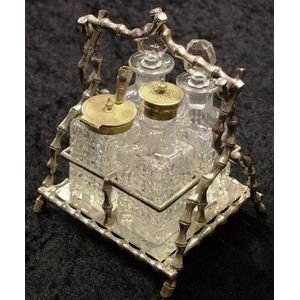Austrian Secessionist Walnut Chair with Acorn Carvings
An Austrian Secessionist carved walnut chair, circa 1900-1910 with carved roundels of acorns and oak leaves. provenance: Purchased from Copeland & de Soos, 66 Queen Street, Woollahra, Sydney, September 27, 1984.
You must be a subscriber, and be logged in to view price and dealer details.
Subscribe Now to view actual auction price for this item
When you subscribe, you have the option of setting the currency in which to display prices to $Au, $US, $NZ or Stg.
This item has been sold, and the description, image and price are for reference purposes only.
- Provenance - A term used to describe the provable history of an antique or work of art, and thus an additional aid to verifying its authenticity. Provenance can have an inflating effect on the price of an item, particularly if the provenance relates to the early settlement of Australia, a famous person, or royalty. Less significant are previous sales of the item through an auction house or dealer.
- Oak - Native to Europe and England, oak has been used for joinery, furniture and building since the beginning of the medieval civilisation. It is a pale yellow in colour when freshly cut and darkens with age to a mid brown colour.
Oak as a furniture timber was superceded by walnut in the 17th century, and in the 18th century by mahogany,
Semi-fossilised bog oak is black in colour, and is found in peat bogs where the trees have fallen and been preserved from decay by the bog. It is used for jewellery and small carved trinkets.
Pollard oak is taken from an oak that has been regularly pollarded, that is the upper branches have been removed at the top of the trunk, result that new branches would appear, and over time the top would become ball-like. . When harvested and sawn, the timber displays a continuous surface of knotty circles. The timber was scarce and expensive and was used in more expensive pieces of furniture in the Regency and Victorian periods. - Circa - A Latin term meaning 'about', often used in the antique trade to give an approximate date for the piece, usually considered to be five years on either side of the circa year. Thus, circa 1900 means the piece was made about 1900, probably between 1895 and 1905. The expression is sometimes abbreviated to c.1900.
This item has been included into following indexes:
- chairs, singles / pairs / threes, timber
- furniture, period or style - Viennese / Austrian Secessionist 12
Visually similar items

Antique silver plated cruet set. Height 20 cm approx
Sold by
in
for
You can display prices in $Au, $US, $NZ or Stg.

Malagan tatuana dance mask, PNG bark mask with grass base and painted designs, height 45 cm
Sold by
in
for
You can display prices in $Au, $US, $NZ or Stg.

Mexican Taxco silver multi-part locket, on metal chain
Sold by
in
for
You can display prices in $Au, $US, $NZ or Stg.

Alice Cayley 'Bird Study' watercolour, signed lower right, 22 x 15 cm
Sold by
in
for
You can display prices in $Au, $US, $NZ or Stg.
